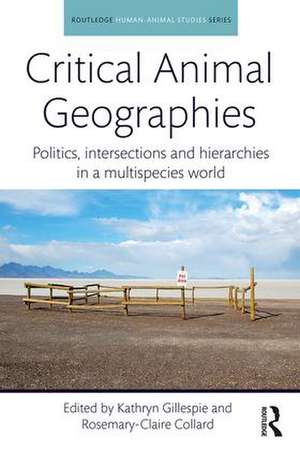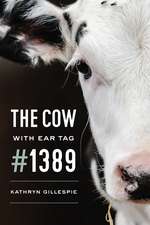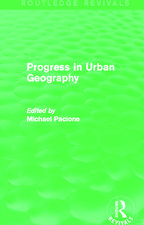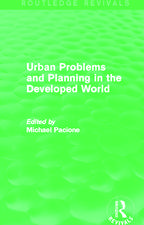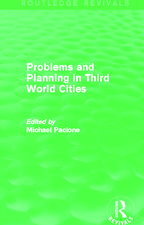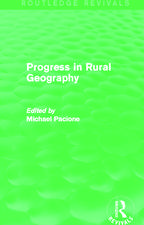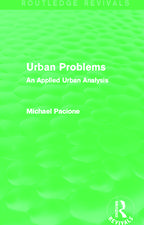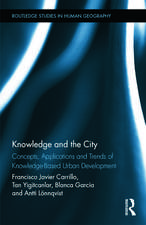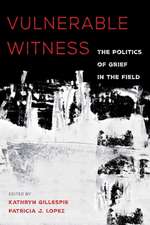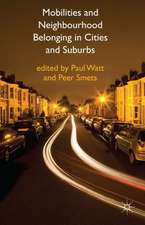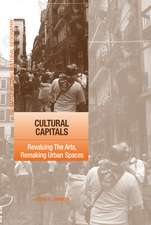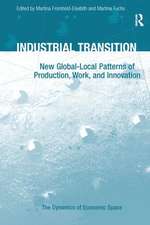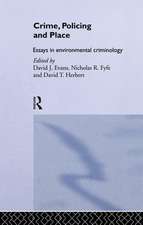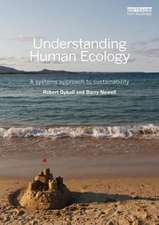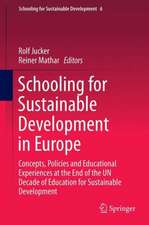Critical Animal Geographies: Politics, Intersections and Hierarchies in a Multispecies World: Routledge Human-Animal Studies Series
Editat de Kathryn Gillespie, Rosemary-Claire Collarden Limba Engleză Paperback – 14 feb 2017
| Toate formatele și edițiile | Preț | Express |
|---|---|---|
| Paperback (1) | 444.62 lei 6-8 săpt. | |
| Taylor & Francis – 14 feb 2017 | 444.62 lei 6-8 săpt. | |
| Hardback (1) | 1001.07 lei 6-8 săpt. | |
| Taylor & Francis – 23 ian 2015 | 1001.07 lei 6-8 săpt. |
Preț: 444.62 lei
Nou
Puncte Express: 667
Preț estimativ în valută:
85.10€ • 92.47$ • 71.53£
85.10€ • 92.47$ • 71.53£
Carte tipărită la comandă
Livrare economică 21 aprilie-05 mai
Preluare comenzi: 021 569.72.76
Specificații
ISBN-13: 9781138634701
ISBN-10: 1138634700
Pagini: 234
Ilustrații: 20
Dimensiuni: 156 x 234 x 20 mm
Greutate: 0.34 kg
Ediția:1
Editura: Taylor & Francis
Colecția Routledge
Seria Routledge Human-Animal Studies Series
Locul publicării:Oxford, United Kingdom
ISBN-10: 1138634700
Pagini: 234
Ilustrații: 20
Dimensiuni: 156 x 234 x 20 mm
Greutate: 0.34 kg
Ediția:1
Editura: Taylor & Francis
Colecția Routledge
Seria Routledge Human-Animal Studies Series
Locul publicării:Oxford, United Kingdom
Public țintă
Postgraduate and UndergraduateCuprins
1 Introduction
Rosemary- Claire Collard and Kathryn Gillespie
PART I Politics
2 Animal geographies, anarchist praxis, and critical animal studies
Richard J. White
3 Practice as theory: learning from food activism and performative protest
Eva Giraud
4 Pleasure, pain, and place: ag-gag, crush videos, and animal bodies on display
Claire Rasmussen
PART II Intersections
5 Wildspace: the cage, the supermax, and the zoo
Karen M . Morin
6 Commodification, violence, and the making of workers and ducks at Hudson Valley Foie Gras
John Joyce, Joseph Nevins, and Jill S. Schneiderman
7 Species, race, and culture in the space of wildlife management
Anastasia Yarbrough
8 Pit bulls, slavery, and whiteness in the mid- to late-nineteenth-century U.S.: geographical trajectories; primary sources
Heidi J. Nast
PART III Hierarchies
9 Coyotes in the city: gastro-ethical encounters in a more-than-human world
Gwendolyn Blue and Shelley Alexander
10 Livelier livelihoods: animal and human collaboration on the farm
Jody Emel, Connie L. Johnston, and Elisabeth (Lisa) Stoddard
11 En-listing life: red is the color of threatened species lists
Irus Braverman
12 Doing critical animal geographies: future directions
Rosemary- Claire Collard and Kathryn Gillespie
Rosemary- Claire Collard and Kathryn Gillespie
PART I Politics
2 Animal geographies, anarchist praxis, and critical animal studies
Richard J. White
3 Practice as theory: learning from food activism and performative protest
Eva Giraud
4 Pleasure, pain, and place: ag-gag, crush videos, and animal bodies on display
Claire Rasmussen
PART II Intersections
5 Wildspace: the cage, the supermax, and the zoo
Karen M . Morin
6 Commodification, violence, and the making of workers and ducks at Hudson Valley Foie Gras
John Joyce, Joseph Nevins, and Jill S. Schneiderman
7 Species, race, and culture in the space of wildlife management
Anastasia Yarbrough
8 Pit bulls, slavery, and whiteness in the mid- to late-nineteenth-century U.S.: geographical trajectories; primary sources
Heidi J. Nast
PART III Hierarchies
9 Coyotes in the city: gastro-ethical encounters in a more-than-human world
Gwendolyn Blue and Shelley Alexander
10 Livelier livelihoods: animal and human collaboration on the farm
Jody Emel, Connie L. Johnston, and Elisabeth (Lisa) Stoddard
11 En-listing life: red is the color of threatened species lists
Irus Braverman
12 Doing critical animal geographies: future directions
Rosemary- Claire Collard and Kathryn Gillespie
Notă biografică
Rosemary-Claire Collard is an Assistant Professor in Geography at Concordia University in Montreal. Her research looks at capitalism, environmental politics, science, and culture, especially film, with an eye to how they depend on and engender certain human-animal relations.
Kathryn Gillespie is a part-time Lecturer in Geography, the Honors Program, and the Comparative History of Ideas Program at the University of Washington in Seattle, Washington. Her research focuses on the lived experience of animals in spaces of commodity production (e.g., farming, breeding, sale, and slaughter), with a particular emphasis on those animals humans use for food.
Kathryn Gillespie is a part-time Lecturer in Geography, the Honors Program, and the Comparative History of Ideas Program at the University of Washington in Seattle, Washington. Her research focuses on the lived experience of animals in spaces of commodity production (e.g., farming, breeding, sale, and slaughter), with a particular emphasis on those animals humans use for food.
Descriere
Critical Animal Geographies provides new geographical perspectives on critical animal studies, exploring the spatial, political and ethical dimensions of animals’ lived experience and human-animal encounter. It works toward a more radical politics and theory directed at the shifting boundary between human and animal. Chapters draw together feminist, political-economic, post-humanist, anarchist, post-colonial, and critical race literatures with original case studies in order to see how efforts by some humans to control and order life – human and not – violate, constrain and impinge upon others. Central to all chapters is a commitment to grappling with the stakes – violence, death, life, autonomy – of human-animal encounters. Equally, the work in the collection addresses head-on the dominant forces shaping – and dependent on – these encounters: capitalism, racism, colonialism, and so on. In doing so, the book pushes readers to confront how human-animal relations are mixed up with overlapping axes of power and exploitation, including gender, race, class, and species.
